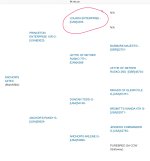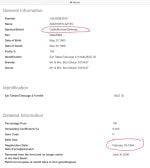Back in the 60s, there was no major Junior shows to drive cattle sales, like they do today, but Louada was able to develop a similar atmosphere. Rather than grown ups trying to buy heifers for their kids and grand kids that they thought might win, grown ups competed between themselves, to buy the top bulls and females in the Louada sales. Many of the Louada sales had averages that would look great today. There were lots of animals selling for $10,000 -$20,000 with an occasional bull selling for more.
When I was 16 years old, I had the pleasure to go to Louada and stay with Wib Donaldson and his wife for 3 days. Gary Latimer( Remitall) and myself, delivered the first Polled Herefords to Louada. Louada still had it's Shorthorn herd, and I remember Denend Constellation was out breeding cows. The $30,000 Louada Bonaparte was still at the farm, as was the $19500 Louada Zenith who had topped the Louada sale a few months previous. Bonaparte had sold to Argentina and they were in the process of getting him ready for the trip there by boat. I remember the Louada farm being a show place and I have often wondered what happened to the farm after the Donaldson's passed away.It was one little piece of heaven on earth. There was a lake on one farm which had a beautiful guest house on it, that most people would love to live in forever. The fences were painted white and everything was pin neat. Louada was a place where many young cattle people from around the world went to learn about breeding cattle. I remember there being two young men from Argentina as well as two from Scotland, one from the US and one from Australia being employed at Louada on that visit. I also remember hearing that these employees were paid very little to work there, and their families paid their trips both ways. Most were sent to Louada just for work experience and the opportunity to work beside one of the great breeders of the day, before they returned to work on their own families breeding operations. I wonder how many kids today would agree to go work for next to nothing today, just for the experience. There are probably lots !
Louada was established by Louis Cadesky, who was a major league industrialist, who developed gold mines. The story goes that Cadesky had been bankrupt 8 times in his adult life, but he always had the best lawyers and accountants he could find working for him, so he was always able to re-establish himself. Wib Donaldson was Cadesky's farm manager, and when Cadesky died, Wib was gifted the Louada Farms. The name Louada was a combination of Louis and Ada Cadesky's names.
There was a time when you looked through a Shorthorn World ( the breed magazine before Shorthorn Country) there was hardly a page where there was not an ad that listed a Louada bull or a son of a Louada bull as a herd sire. Wib went on to develop a powerful Polled Hereford herd after the Shorthorns were dispersed, and it enjoys good success, however, it never achieved the status of the Shorthorn herd.
Getting back to the trip we made to Louada, I am oftentimes amazed when I think about it. Gary Latimer and I were both 16 years old and we had both just had our driver's licence a few short months. The morning after Remitall dispersed their Shorthorn herd, I remember Louis Latimer asking my dad if he would allow me to help Gary deliver cattle literally close to 2800 miles across Canada. For some reason my dad agreed to this, and I should ask him about that decision some day.( after all we were both only 16 years old) Gary and I left the following morning with a full load of cattle in a special built Fargo truck with a 34 ft box on it ( we found out later on that trip that the truck was 4 ft too long for legal driving in Ontario, when we were stopped by the police and held in custody for 4 hours while they decided what they were going to do with us... they eventually allowed us to leave as we were within 200 miles of the Ontario border, but they made us promise that we would never return to Ontario. I have broken that promise more than a few times since ).
The load consisted of both Shorthorns from the dispersal, and Polled Herefords going to Louada. We made several stops through Alberta and Saskatchewan at both Shorthorn and Polled Hereford farms. We bought cattle( mostly bulls) at almost every stop. Remitall had a policy of buying bulls from breeders who purchased herd bulls from them. They had a couple of bull dealers in Idaho and Oregon, that they shipped these bulls to, and they re-sold them. Some of the best bulls were retained and developed at Remitall and resold from there. On the trip back to Alberta we stopped at these farms where we had purchased the cattle and loaded them, so we were literally full of cattle in both directions. I remember loading 5 Polled Hereford bred heifers at a well know breeder of the day, in Manitoba using a block and tackle that was connected to a chain that we hooked to a tractor. We backed the truck up to a manure pile and we haltered the heifers in the barn and pulled them to the truck with the tractor. Once we got them close enough we connected the block and tackle to the halter and hooked the tractor to the block and tackle. Once we got the front end of the heifers high enough we all got behind them and literally pushed and lifted them into the truck. This all took place while we had to keep the cattle in the truck from jumping out. If I remember correctly we were most part of an afternoon loading 5 heifers. Gary paid this guy for these heifer in cash, and I remember him telling him to use the money to build a loading chute.
Not only am I amazed that we made this trip when we were both 16 years old, but I am amazed that the entire trip was done in cash. There was no such thing as a credit card or a debit card in those days. I have no idea how much cash we were carrying, as we had enough to buy gas, meals, motels, repairs, and even paid cash for some of the cattle we purchased. Those were the good old days......


